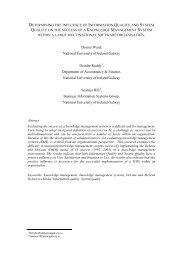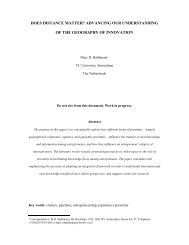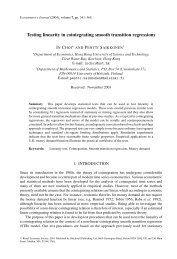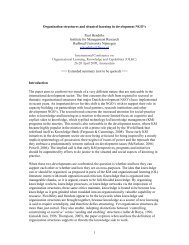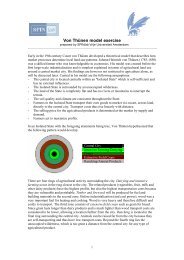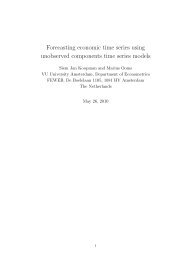The effects of road pricing - Feweb - Vrije Universiteit Amsterdam
The effects of road pricing - Feweb - Vrije Universiteit Amsterdam
The effects of road pricing - Feweb - Vrije Universiteit Amsterdam
You also want an ePaper? Increase the reach of your titles
YUMPU automatically turns print PDFs into web optimized ePapers that Google loves.
a limit on the precision with which rate structures can reflect specific costs, although<br />
new electronic <strong>pricing</strong> systems reduce transaction costs.<br />
When governments are unable to impose marginal cost <strong>pricing</strong> in other markets than<br />
transport, marginal cost <strong>pricing</strong> in transport itself would typically no longer be<br />
optimal. A straightforward example concerns labour taxes that would distort the<br />
labour market. When these exist, it is to be expected that optimal congestion charges<br />
for <strong>road</strong> transport – mainly affecting commuters and hence affecting labour supply<br />
decisions – would not only reflect marginal external congestion costs but in addition<br />
would also reflect the current distortions on the labour market.<br />
Social policy is not only concerned with efficiency, but also with equity. In the<br />
absence <strong>of</strong> instruments that enable the government to redistribute resources without<br />
distortions, this may require prices that deviate from marginal costs, for instance when<br />
luxury goods are taxed heavily (see also Section 2.3.2).<br />
<strong>The</strong> implication <strong>of</strong> this list <strong>of</strong> reasons is that it should not be expected that in actual<br />
economies all prices will be (or can even be) equal to marginal costs. <strong>The</strong> transport<br />
market is characterised by several market imperfections which makes it very unlikely<br />
that the market, without regulation, will set transport prices equal to marginal social<br />
costs and, therefore, social welfare is not optimised. In the following, three specific<br />
market failures that play an import role in the transport market will be discussed;<br />
namely, externalities, cost-related issues (i.e. economies <strong>of</strong> scale, indivisibilities and<br />
common costs), and monopolies. In addition, some remarks will be made on the<br />
question <strong>of</strong> whether it is possible to correct for these market failures and in which<br />
way.<br />
2.4.2 Externalities<br />
<strong>The</strong> essence <strong>of</strong> an externality is that it involves (i) interdependence between two or<br />
more economic agents, and (ii) failure to price that interdependence. Formally,<br />
externalities exist when the activities <strong>of</strong> one group (either consumers or producers)<br />
unintentionally affect the welfare <strong>of</strong> another group, without any payment or<br />
compensation being made (Button, 1993). Most attention in transport is paid to the<br />
negative (costs) externalities, although also positive externalities (benefits) have been<br />
identified (for a discussion on this latter issue, see Verhoef (1996)). It is quite clear<br />
from everyday experience, that there are costs associated with transport that are not<br />
directly borne by those generating them. Transport generates many negative<br />
externalities, including noise, accidents, pollution, and congestion. Road travellers,<br />
for example, impose noise and vibration costs on those living adjacent to highways. In<br />
the introduction we noticed that these costs may be significant. Total congestion costs<br />
may be small compared with other externalities, but marginal congestion costs can be<br />
substantial in comparison to other marginal external costs (e.g. marginal external cost<br />
estimates from a Dutch study indicate that the external congestion costs exceed the<br />
other external cost categories by several orders <strong>of</strong> magnitude (CE, 1999)).<br />
A result <strong>of</strong> the clear presence <strong>of</strong> externalities in transport is that the early neo-classical<br />
writers studying market failures frequently illustrated their viewpoints using transport<br />
examples. Dupuit was the one <strong>of</strong> the first in 1844 to illustrate efficient <strong>pricing</strong> <strong>of</strong><br />
public goods (Button and Verhoef, 1998). Coase (1960) considered the absence <strong>of</strong><br />
property rights in relation to the existence <strong>of</strong> externalities for a railway. Another wellknown<br />
example is that <strong>of</strong> a congested <strong>road</strong>, including optimal congestion charges<br />
(Pigou in 1920). <strong>The</strong>y all showed that the market mechanism fails to allocate<br />
resources efficiently.<br />
18





